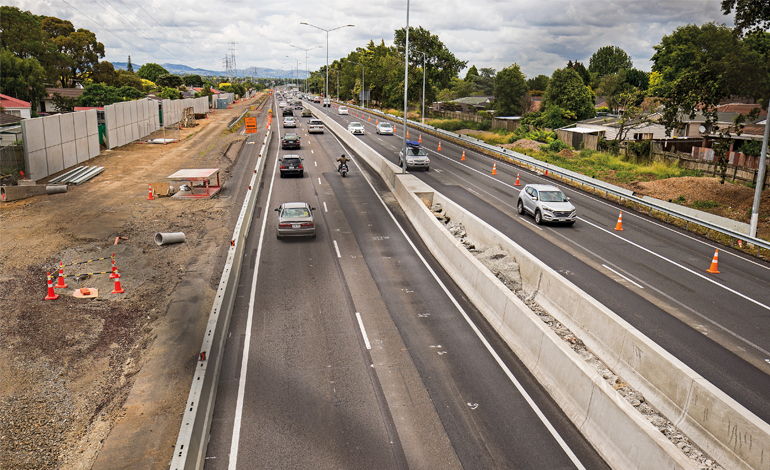A $268 million project in Auckland will address severe congestion issues plaguing the Southern Motorway that creates delays for freight and commuter vehicles. By MARY SEARLE BELL.
 AN ESSENTIAL PART of Auckland’s motorway network, the Southern Motorway is the primary route between Auckland and Hamilton, and the corridor for freight in and out of the region.
AN ESSENTIAL PART of Auckland’s motorway network, the Southern Motorway is the primary route between Auckland and Hamilton, and the corridor for freight in and out of the region.
Every day some 110,000 vehicles travel in both directions between State Highway 20 and Hill Road, and 85,000 between Hill Road and Takanini.
The Southern Corridor Improvements project concerns the stretch of the Southern Motorway from the interchange with State Highway 20 at Manukau southwards down to Papakura and is designed to address bottlenecks at several locations caused by an imbalance in the number of lanes heading both north and south, which fluctuates from three to two lanes between Hill Road and Takanini.
The opening of the Waterview Tunnels this year and the completion of the Western Ring Route (an alternative state highway route through Auckland) in 2021 will increase the amount of southbound traffic reaching State Highway 1 at this point in the motorway.
The upgrade will see the motorway widened and more lanes added to improve traffic flow. Southbound, the new configuration will see four lanes (currently three) between the SH1/SH20 connection and Hill Road, and three lanes (currently two).
CPB Contractors (formerly Leightons) began work in October 2015; now, more than a year later, good progress has been made. Widening works are well underway, bringing narrowed lanes on the motorway and lower speed limits as the contractors work in the road corridor.
So far, the southbound side of the motorway under Alfriston Road has been lowered in to allow the addition of the third lane.
Pavements have been constructed in the median between Pahurehure Inlet and Alfriston Road. Traffic has been moved across to the median to allow works to progress on the southbound shoulder, where the new pavements will soon be completed and tied into the existing lanes.
Permanent noise walls made of precast concrete are being constructed along the southbound side of the motorway between Pahurehure Inlet and Alfriston Road. And, as the area along the motorway is not entirely flat, some locations have needed retaining walls to create a level and stable surface for the noise wall.
The NZTA says the Hill Road to Takanini southbound section should be open by March. The extra lane will help accommodate the increase in traffic expected as a result of the Waterview Tunnel opening in April.
There are 23 bridges on the project that will either be modified or built from scratch. These include four new bridges as part of the upgraded Takanini Interchange, and three cycle/pedestrian bridges at Pescara Point and Pahurehure Inlet.
The NZTA says most the bridge work in the project involves widening the existing structures, which is complex for both the design and construction as the existing traffic flows must be maintained. The existing structures near Takanini are very narrow which does not allow much construction space for tie-in works.
In the case of the Orams Road bridge, the entire span requires widening to allow the construction of an additional lane underneath. This will require the current bridge to be demolished, and means it will be closed and traffic diverted for several months while this work is carried out.
As part of the project, a new, 4.5-kilometre-long shared walking and cycle path is being constructed from Papakura to Great South Road. A new pedestrian bridge is being built over State Highway 1 at the southern end of the Pahurehure Inlet (at Pescara Point). A steel orthotropic box girder with triangular cross-section, the structure will have a variable depth along the three spans, with the central span stretching 45 metres. The bridge will curve in both horizontal and vertical alignments.
Adding additional challenges to the project, the North Island Main Trunk railway line runs alongside the motorway. There are two existing structures over the tracks within the project area – one for northbound traffic and a second for southbound. These both require widening. The NZTA says one of the main challenges here is to avoid reducing the clearance to the railway due to the extension of the cross fall.
There are also two new structures to be constructed over the rail corridor – one for the northbound on-ramp and one for the southbound on-ramp.
In addition, associated changes are being made to the overhead electrical lines for the railway as well as some utilities relocations within the corridor.
With much of the work on the southbound lane complete, this year the project focus has shifted to the construction of the new northbound lane between Papakura and Takanini interchanges. Vegetation clearing was started in late 2016 and other preparatory work, such as earthworks, drainage and noise wall construction, began in January.
The project is scheduled to be completed in 2018.

